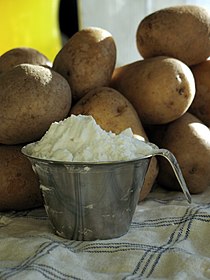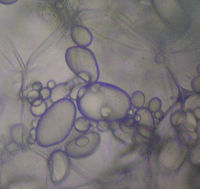
Starch or amylum is a polymeric carbohydrate consisting of numerous glucose units joined by glycosidic bonds. This polysaccharide is produced by most green plants for energy storage. Worldwide, it is the most common carbohydrate in human diets, and is contained in large amounts in staple foods such as wheat, potatoes, maize (corn), rice, and cassava (manioc).

Flour is a powder made by grinding raw grains, roots, beans, nuts, or seeds. Flours are used to make many different foods. Cereal flour, particularly wheat flour, is the main ingredient of bread, which is a staple food for many cultures. Corn flour has been important in Mesoamerican cuisine since ancient times and remains a staple in the Americas. Rye flour is a constituent of bread in both Central Europe and Northern Europe.

Tapioca is a starch extracted from the tubers of the cassava plant, a species native to the North and Northeast regions of Brazil, but whose use is now spread throughout South America. It is a perennial shrub adapted to the hot conditions of tropical lowlands. Cassava copes better with poor soils than many other food plants.

Sago is a starch extracted from the pith, or spongy core tissue, of various tropical palm stems, especially those of Metroxylon sagu. It is a major staple food for the lowland peoples of New Guinea and the Maluku Islands, where it is called saksak, rabia and sagu. The largest supply of sago comes from Southeast Asia, particularly Indonesia and Malaysia. Large quantities of sago are sent to Europe and North America for cooking purposes. It is traditionally cooked and eaten in various forms, such as rolled into balls, mixed with boiling water to form a glue-like paste (papeda), or as a pancake.

Mochi is a Japanese rice cake made of mochigome (もち米), a short-grain japonica glutinous rice, and sometimes other ingredients such as water, sugar, and cornstarch. The steamed rice is pounded into paste and molded into the desired shape. In Japan, it is traditionally made in a ceremony called mochitsuki. While eaten year-round, mochi is a traditional food for the Japanese New Year, and is commonly sold and eaten during that time.

A croissant is a French pastry made from puff pastry in a crescent shape.

The Autochrome Lumière was an early color photography process patented in 1903 by the Lumière brothers in France and first marketed in 1907. Autochrome was an additive color "mosaic screen plate" process. It was the principal color photography process in use before the advent of subtractive color film in the mid-1930s.

Angel food cake, or angel cake, is a type of sponge cake made with egg whites, flour, and sugar. A whipping agent, such as cream of tartar, is commonly added. It differs from other cakes because it uses no butter. Its aerated texture comes from whipped egg white. Angel food cake originated in the United States and first became popular in the late 19th century. It gained its unique reputation along with its name due to its light and fluffy texture and white color.

Cornflour, cornstarch, maize starch, or corn starch is the starch derived from corn (maize) grain. The starch is obtained from the endosperm of the kernel. Corn starch is a common food ingredient, often used to thicken sauces or soups, and to make corn syrup and other sugars. Corn starch is versatile, easily modified, and finds many uses in industry such as adhesives, in paper products, as an anti-sticking agent, and textile manufacturing. It has medical uses as well, such as to supply glucose for people with glycogen storage disease.

Amylopectin is a water-insoluble polysaccharide and highly branched polymer of α-glucose units found in plants. It is one of the two components of starch, the other being amylose.
Starch gelatinization is a process of breaking down of intermolecular bonds of starch molecules in the presence of water and heat, allowing the hydrogen bonding sites to engage more water. This irreversibly dissolves the starch granule in water. Water acts as a plasticizer.

Rye bread is a type of bread made with various proportions of flour from rye grain. It can be light or dark in color, depending on the type of flour used and the addition of coloring agents, and is typically denser than bread made from wheat flour. Compared to white bread, it is higher in fiber, darker in color, and stronger in flavor. The world's largest exporter of rye bread is Poland.
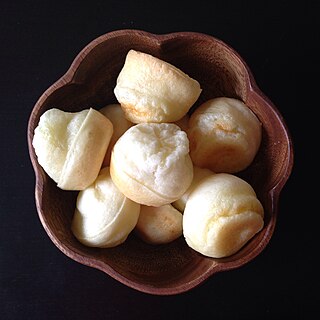
Pão de queijo or Brazilian cheese buns is a small, baked cheese roll or cheese bun, a popular snack and breakfast food in Brazil. It is a traditional Brazilian recipe, originating in the state of Minas Gerais.

Lahoh, is a spongy, flat pancake-like bread. It is a type of flat bread eaten regularly in Somalia, Djibouti, Ethiopia and Yemen. Yemenite Jewish immigrants popularized the dish in Israel. It is called Canjeero/Canjeelo in southern Somalia and Djibouti, and also called Laxoox/Lahoh in northern Somalia, respectively.

Modified starch, also called starch derivatives, is prepared by physically, enzymatically, or chemically treating native starch to change its properties. Modified starches are used in practically all starch applications, such as in food products as a thickening agent, stabilizer or emulsifier; in pharmaceuticals as a disintegrant; or as binder in coated paper. They are also used in many other applications.

Flourless chocolate cake is a dense cake made from an aerated chocolate custard. The first documented form of the cake was seen in Ferrara, Italy, though some forms of the cake have myths surrounding their origins. The dessert contains no gluten which makes it acceptable for those with celiac disease, gluten-free diets, and during religious holidays in which gluten and grains are not permitted.
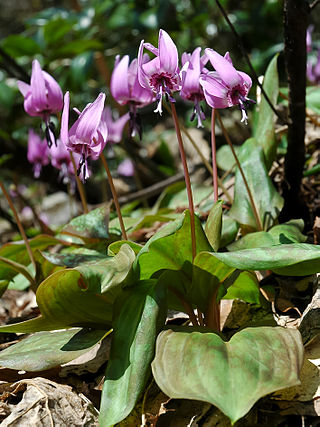
Erythronium japonicum, known as Asian fawn lily, Oriental fawn lily, Japanese fawn lily is a pink-flowered species trout lily, belonging to the Lily family and native to Japan, Korea, the Russian Far East and northeastern China. It is a spring ephemeral, blooming April–June in woodlands. It is known as zhūyáhuā (猪牙花) in Chinese, eolleji (얼레지) in Korean, and katakuri in Japanese.
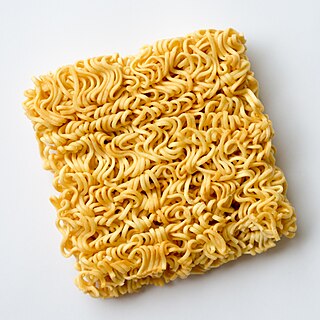
Instant noodles, or instant ramen, is a type of food consisting of noodles sold in a precooked and dried block with flavoring powder and/or seasoning oil. The dried noodle block was originally created by flash-frying cooked noodles, and this is still the main method used in Asian countries; air-dried noodle blocks are favored in Western countries. Dried noodle blocks are designed to be cooked or soaked in boiling water before eating. Ramen, a Japanese adaptation of Chinese noodle soup, is sometimes used as a descriptor for instant noodle flavors by some Japanese manufacturers. It has become synonymous in the United States with all instant noodle products.
Starch production is an isolation of starch from plant sources. It takes place in starch plants. Starch industry is a part of food processing which is using starch as a starting material for production of starch derivatives, hydrolysates, dextrins.
Arrowroot is a starch obtained from the rhizomes (rootstock) of several tropical plants, traditionally Maranta arundinacea, but also Florida arrowroot from Zamia integrifolia, and tapioca from cassava, which is often labeled arrowroot. Polynesian arrowroot or pia, from Palawan-Philippines arrowroot ("uraro/araro"), and Japanese arrowroot, also called kudzu, are used in similar ways. In India, it is called palua.
